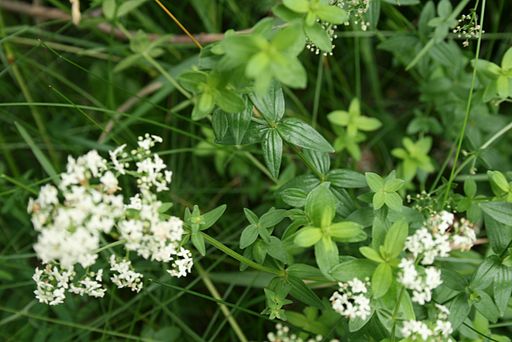|
Every flower is a soul blossoming in nature.
Gerard De Nerval This native perennial herb is a member of the coffee family and its tiny seeds can be roasted as a coffee substitute. A native to Northern Europe as well as North America, its pleasant smell when dried(like newly mown grass) has made it popular historically in Europe as a stuffing for mattresses and pillows. It grows by seed and by rhizomes and although rare, is widely distributed. The efficiency of its propagation by rhizomes causes it to sometimes form dense stands. Some of its species produce a chemical called asperuloside. Asperuloside can produce coumarin which is the compound that gives Northern bedstraw its sweet smell. Coumarin repels insects which was another reason for its popularity as bedding. Coumarins have reportedly caused toxicity to the liver and the kidney. Furthermore, some forms of coumarin block Vitamin K. Without vitamin K, the protein produced by the liver to clot blood is reduced. This causes an increased bleeding risk and if a lot of coumarin is consumed, fatal bleeding can occur. Coumarin has been used medicinally to treat blood clots and prevent strokes in patient's with heart arrhythmias. This genus is of great interest to the pharmaceutical industry because asperuloside can be converted into prostaglandins. Plants For A Future(PFAF) report that the young plant leaves are edible both raw or cooked. However given its possible toxicity, caution is advised especially for women or for anyone with a bleeding condition. Just about all grazing animals and birds eat this plant. The nectar of its small flowers attracts small bees and small flies. So it is considered a good plant to attract native pollinators as well as beneficial insects. (Beneficial insects help reduce populations of pest insects) Its flowers and leaves are food for insects, moths and butterflies. We still don't know a lot about its faunal relationships. This plant and members of its family, play an important role in healthy ecosystems of North America and Europe. It provides food for insects as well as animals. It has multiple known useful functions for humans, and is being studied further for its medicinal potential. We would be wise to revere this plant and learn more about the many roles it plays and its importance for the many plants and animals associated with it. http://en.wikipedia.org/wiki/Galium_boreale http://www.pfaf.org/user/Plant.aspx?LatinName=Galium+boreale http://books.google.ca/books?id=wCODAwAAQBAJ&pg=PA116&lpg=PA116&dq=what+animals+eat+galium+boreal&source=bl&ots=Qm_pJszLaK&sig=ZB-CYbdhmVB7JFylyjVCYuIA5Rs&hl=en&sa=X&ei=6_5WVNWOK9SeyATDhoCIAw&ved=0CC8Q6AEwAg#v=onepage&q=what%20animals%20eat%20galium%20boreal&f=false http://www.illinoiswildflowers.info/prairie/plantx/wild_madderx.htm http://homebuggarden.blogspot.ca/2010_07_01_archive.html
0 Comments
Leave a Reply. |
CategoriesAuthorManitoba is where I was born and where I have spent most of the five and one half decades of my life. I lived on the outskirts of the town of Portage La Prairie at a time when tadpoles and frogs inhabited the ditches and ponds, when there were many Monarch butterflies each summer along with dragon flies and grasshoppers. Redwing blackbirds perched the cattails of the ditches. As children we picked dandelions for bouquets and made wishes before blowing dandelion seed heads. We searched clover for lucky four leaves and rolled on the grass…there was no concern of poisonous herbicides. The grass was thick. Wherever we dug…there were earthworms Archives
September 2015
|
Photo used under Creative Commons from wackybadger

 RSS Feed
RSS Feed
